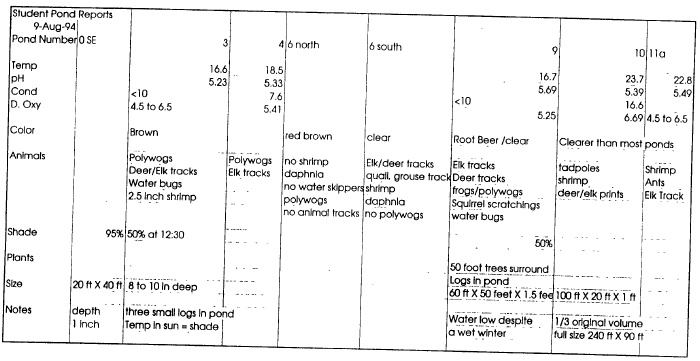August 9, 1993, Third Trip
This was a very special research trip. Several students from Rogue Community College accompanied the author. The day was spent observing the ponds and collecting samples for later study. Some of these student reports are included in Appendix II.
The plan was to allow a student to study a single pond. In this way several ponds would be studied in detail. An in situ probe was used to measure pH, temperature, and conductivity. Water samples were taken and analyzed for dissolved oxygen and phytoplankton (Table 1). The temperatures of the ponds ranged from 23.7 to 16.60 C, the conductivity from 7.6 to 16.6 uMho/cm, the pH from 5.23 to 5.69 units, and the dissolved oxygen concentrations from 4.50 to 6.69 mg/L (Table 2). Ponds observed on this field day included #0, 3, 4, 6, 9, 10, and 11. Notes on special conditions follow.
|
Table 2. August 9, 1993 observations of Whitehorse Ponds with Rogue Community College students. |
Pond #0 SE is not shown on any map. However two students selected it for study. Surrounded by tall trees, it was well shaded. The bottom was covered with grass and had only about an inch of water in it. Several zooplankton were collected and drawn in the lab at Rogue Community College (RCC). No chemical sampling was completed here since it was so far away from the main group of ponds. It lies far to the south east on the bluff.
Ponds #1 and 2 were not observed. Pond #3 was a tea brown color. This pond had the coolest water and the temperature changed little in the sun or in the shade. The conductivity of this water was less than 10 uMho/cm.
Pond #4 was observed and had several parameters recorded for it (Table 1). Pond #5 was not observed. Pond #6 had dried into two basins by this date. The north and south basin were not similar in many respects. Pond #6 north was a reddish color and had many pollywogs with shrimp and animal tracks around it. Pond #6 south was clear and had numerous elk and deer tracks along the shore as well as the tracks of grouse and quail. There were shrimp in this south pond but no pollywogs. These two basins were very different from each other on this date.
Ponds #7 and 8 were not observed on this date. Pond #9 was sampled and another pond to the east of the main pond was discovered. We called the unmapped pond, #13 or Pond #9 east. Pond #9 was a root beer color. It had elk tracks as well as pollywogs and frogs in evidence. There were logs in the pond and it was half shaded by 50 foot tall hemlock trees.
Pond #10 was the warmest pond observed and had a temperature of 23.70 C. It also had the highest conductivity of 16.6 uMho/cm. This pond was clearer than most ponds and was observed to contain shrimp. It was about one third of its filled size.
Pond #11a also had shrimp. It was quite warm with a temperature of 22.80 C. Pond #12 was not observed on this date.


